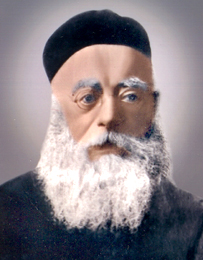|
|
Missionsschwestern |
|
P. Antonius Maria Bodewig
|
P. Antonius Maria Bodewig (1839 - 1915)The FounderFr. A. M. Bodewig was born on 2 November 1839 in Bonn, near city of Cologne. At the age of 17, he completed the gymnasia studies. He then joined the German province of the Society of Jesus in Muenster on 21 August 1856. He began his noviciate formation on 14 October 1856. After two years of training in the province's noviciate, in 1858 this young novice pronounced his religious vows. This was also the year when the German province took charge of the twin-Vicariate of Bombay-Pune Mission in India. After the noviciate formation, the young religious, Bodewig did his philosophical studies at Aachen and later on his three years language courses at Bonn. Bodewig received the diaconate on 11 October 1868. From 1869-1872, he did his Regency, an apprenticeship in modern equivalence, and taught. On May 3,1871, he was ordained a priest in Maria Laach by Bishop Eberhard of Trier. He completed his theological studies in 1872 in Maria Laach, at the theological Institute of the Jesuit society. In the same year, Bodewig received the mandate to go to the mission field of the German province, Bombay-Pune Mission. In the beginning of the year 1873, we meet the young missionary, Bodewig "doing his tertianship along with 10 other fellow Jesuits in Byculla. It is said of him that he knew 17 languages and obtained 4 doctorates. In India he studied Indian Philosophy, Mythology, and the Indian languages Sanskrit and Marathi. The Bishop placed his hope in Bodewig, a young and zealous missionary, who shared his vision and optimism. On 23 January 1874, Fr. Bodewig came to Igatpuri. Bishop Meurin advised Bodewig to lead an orthodox life of an Indian Brahmin. He lived their as Christian Sannyasi for 9 months and completed the construction of the parish Church. Thereafter he was called back to Bombay to teach in St. Xavier’s College of the Jesuits. Knowing the situations of the poor and marginalized specially the illiterate women, widows and children he was moved with compassion and wanted to render his services to them. He sought ways and means of liberating them but his superiors needed him as lecturer in the Colleges and persuaded him to teach in their institutions. Finally they transferred him to America to put an end to his idea of Indian mission. After 12 years of discernment he decided to leave the Jesuits society in order to become an effective missionary to the poor of India. He had a particular vision of this new missionary project. He did not want to found a religious community in line with the traditional monastic or semi-monastic styles of living. He wanted to establish an entirely new Congregation, which would specialize itself in a totally new mode of life. He wanted its apostolate uniquely culture-specific and responding to the specific needs of his time. He planned something that was intrinsically revolutionary in the Church in the given historical context, namely, the Sisters being trained as nurses, midwives and doctors 21 to work as Zanana Missionaries. His main motif was that his members to identify themselves with the people for whom they worked. In contemplating such a vision, Bodewig was so many decades ahead of his time; and so, naturally, he met severe opposition and hindrances on the road .to the realisation of this master plan. In spite of his crucial suffering, many humiliations and setbacks in his life, with unshakable faith in God’s providential care, he placed his unique plan in the hearts of men and women. On 8th January 1915, in a moment when he hoped for the realization of his dream he was called to his divine home for his eternal reward. His followers in turn have carried his plan and worked hard towards the canonical establishment of the Congregation. On 1st July was the day of rejoicing as the Church announced its canonical recognition as a missionary Congregation. |
|
|
RETURN TO PREVIOUS PAGE |

